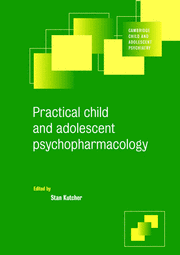Book contents
- Frontmatter
- Contents
- List of contributors
- Preface and acknowledgements
- 1 Child and adolescent psychopharmacology at the turn of the millennium
- 2 Developmental psychopharmacology
- 3 Clinical aspects of child and adolescent psychopharmacology
- 4 Depression
- 5 Bipolar mood disorders: diagnosis, etiology, and treatment
- 6 Schizophrenia and related psychoses
- 7 Obsessive–compulsive disorder
- 8 Anxiety disorders
- 9 Attention-deficit/hyperactivity disorder
- 10 Pervasive development disorder
- 11 Aggressive behavior
- 12 Adolescent substance use disorder
- 13 Tic disorders and Tourette's syndrome
- 14 Eating disorders and related disturbances
- 15 Medical psychiatric conditions
- Index
5 - Bipolar mood disorders: diagnosis, etiology, and treatment
Published online by Cambridge University Press: 31 August 2009
- Frontmatter
- Contents
- List of contributors
- Preface and acknowledgements
- 1 Child and adolescent psychopharmacology at the turn of the millennium
- 2 Developmental psychopharmacology
- 3 Clinical aspects of child and adolescent psychopharmacology
- 4 Depression
- 5 Bipolar mood disorders: diagnosis, etiology, and treatment
- 6 Schizophrenia and related psychoses
- 7 Obsessive–compulsive disorder
- 8 Anxiety disorders
- 9 Attention-deficit/hyperactivity disorder
- 10 Pervasive development disorder
- 11 Aggressive behavior
- 12 Adolescent substance use disorder
- 13 Tic disorders and Tourette's syndrome
- 14 Eating disorders and related disturbances
- 15 Medical psychiatric conditions
- Index
Summary
Introduction
Bipolar disorder in adolescents and children has recently become the focus of increasing study. Debate about its age of onset, phenomenology, comorbidity, course, outcome, and treatment is vigorous and yet, in many cases, still uninformed by sufficient evidence. The “classic” prototype of bipolar I disorder has emerged with some clarity in this population. Less is known about bipolar II or the spectrum of biphasic mood lability of mood dyscontrol.
Diagnostic issues
Epidemiology
There have only been a small number of reports regarding bipolar mood disorder (BMD) in children and adolescents. A retrospective study of adult BMD patients estimated that 0.5% had an age of onset of 5–9 years and 7.5% had an onset of 10–14 years when the first manic episode struck (Loranger and Levine, 1978; Geller et al., 1995). North American studies estimate the point prevalence at 0.2–0.4% for the prepubertal population and about 1.0% in adolescents (Lewinsohn et al., 1995; Zarate and Tohen, 1996; Bland, 1997) with no identified gender differences in prevalence.
Diagnosis and phenomenology
Case reports of mania in preschool and prepubertal children have appeared dating back to the mid-19th century and early Greek writers identified this disorder as being of adolescent onset (Weller et al., 1995). However, explicit criteria to diagnose mania in children first came into practice only in 1960.
Keywords
- Type
- Chapter
- Information
- Practical Child and Adolescent Psychopharmacology , pp. 106 - 133Publisher: Cambridge University PressPrint publication year: 2002
- 2
- Cited by



